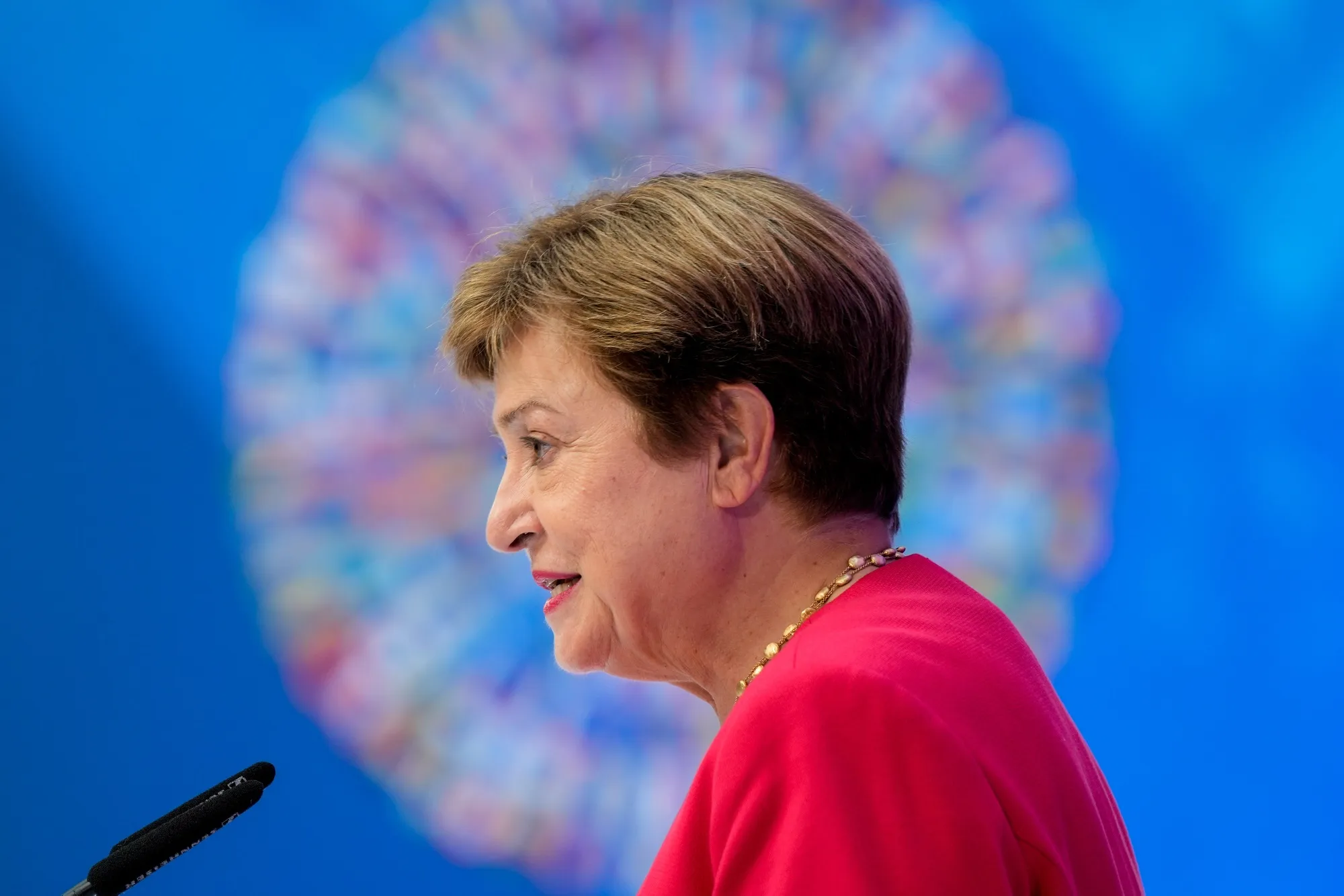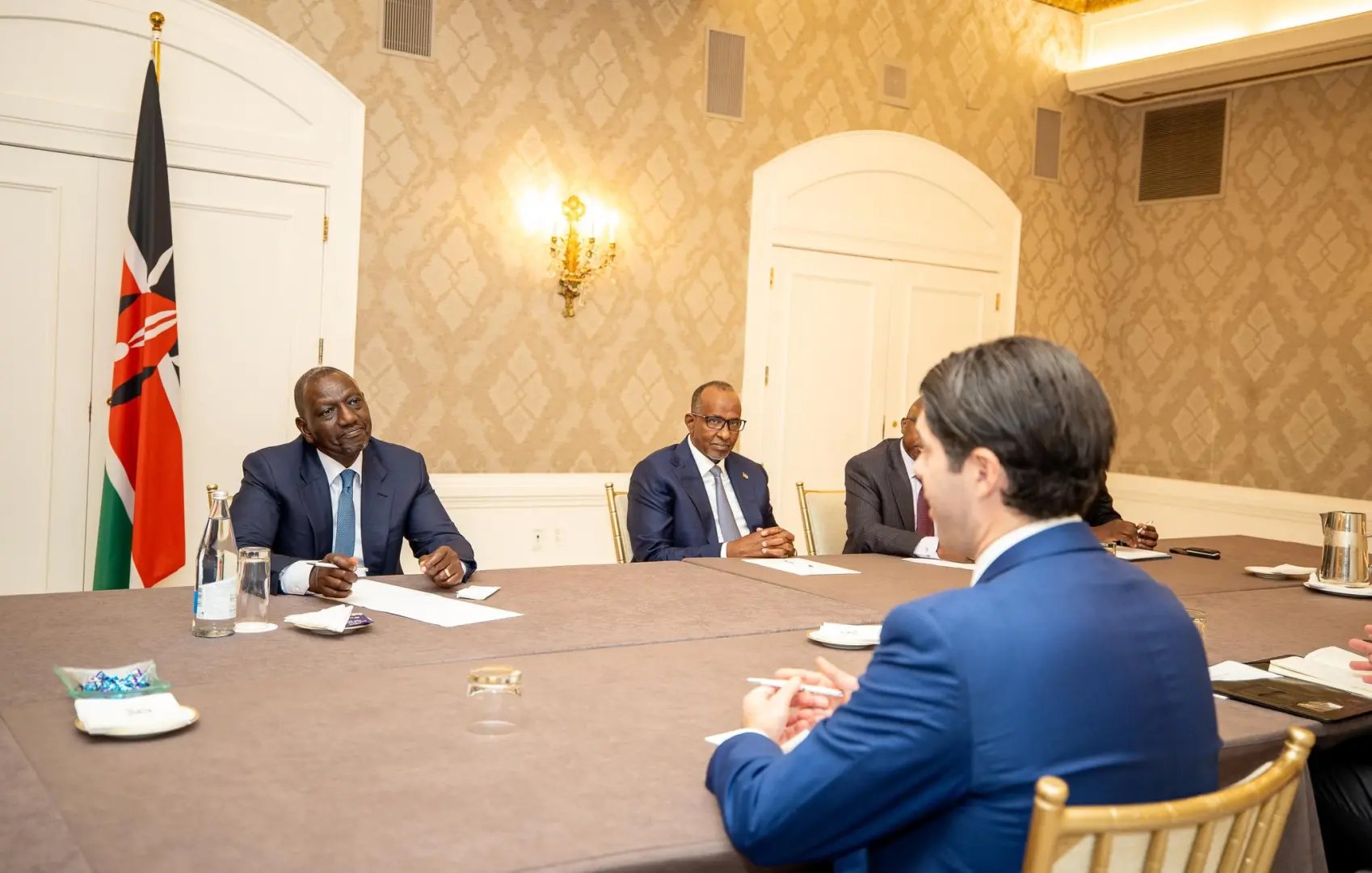The International Monetary Fund (IMF) has sounded a clear alarm: escalating military action by the United States against Iran carries the serious risk of amplifying global economic uncertainty, with potential reverberations extending far beyond the immediate sphere of energy markets. Speaking to Bloomberg on Monday, June 23, 2025, IMF Managing Director Kristalina Georgieva emphasized that the multilateral financial institution is meticulously monitoring the evolving situation in the Middle East, paying particular attention to the conflict’s potential impact on crucial oil and gas prices and vital supply routes.
Georgieva’s urgent remarks closely follow reports of the U.S. military conducting targeted strikes on nuclear facility sites in Iran. These actions effectively deepen American involvement in Israel’s ongoing campaign to dismantle Iran’s nuclear program, despite Tehran’s unequivocal threats of retaliation that could ignite a broader and more devastating regional conflict. U.S. President Donald Trump asserted that Iran’s key nuclear sites were “completely and fully obliterated” and issued a stern warning against any retaliatory attacks, emphasizing that the U.S. possesses the capacity to strike additional targets “with precision, speed and skill.”
For the IMF, this latest geopolitical flashpoint represents “another source of uncertainty in what has been a highly uncertain environment,” as Georgieva conveyed to Bloomberg. The institution’s immediate focus is on two critical elements: “One, how would that impact risk premia for oil and gas. There has been some movement upward— how far would it go? And two: would there be any disruption in energy supplies?” While Georgieva acknowledged, “For now, no,” she concluded with a prayerful hope for de-escalation: “But let’s see how events would develop— whether either delivery routes or spillovers to other countries may occur. I pray, no.”
The Geopolitical Quake: US Strikes, Iranian Threats, and Regional Tensions
The backdrop to the IMF’s warning is a highly volatile geopolitical landscape in the Middle East, a region perpetually at the intersection of energy interests, religious complexities, and historical grievances. The reported U.S. airstrikes on Iranian nuclear facilities represent a significant escalation in a long-standing, multifaceted confrontation. The American rationale for these strikes is rooted in concerns over Iran’s nuclear ambitions, with the stated objective of degrading or dismantling its nuclear program, which the U.S. and its allies believe could be used to develop nuclear weapons. This aligns with Israel’s persistent calls for a firm stance against Iran’s nuclear development, viewing it as an existential threat.
Iran, for its part, has consistently denied seeking nuclear weapons, asserting its right to peaceful nuclear technology under the Nuclear Non-Proliferation Treaty (NPT). However, its past nuclear activities and current enrichment levels, especially following the 2018 U.S. withdrawal from the Joint Comprehensive Plan of Action (JCPOA) – commonly known as the Iran nuclear deal – have fueled international anxieties. The JCPOA, a landmark agreement reached in 2015 between Iran and the P5+1 group (China, France, Germany, Russia, the United Kingdom, and the United States), aimed to limit Iran’s nuclear program in exchange for sanctions relief. Its collapse under the previous U.S. administration and subsequent ‘maximum pressure’ campaign have led to Iran gradually increasing its uranium enrichment, pushing it closer to weapons-grade material, and thus escalating tensions.
Tehran’s threats of retaliation are not to be taken lightly. Iran possesses a sophisticated array of asymmetrical warfare capabilities, including a formidable ballistic missile program, a network of regional proxies (such as Hezbollah in Lebanon, Houthi rebels in Yemen, and various militias in Iraq and Syria), and the capacity to disrupt vital shipping lanes. Any retaliatory action could involve direct strikes on U.S. interests or allies in the region, cyberattacks, or, most critically for the global economy, attempts to disrupt maritime traffic in the Persian Gulf.
IMF’s Economic Watchtower: Uncertainty, Risk Premia, and Supply Chain Vulnerabilities
Kristalina Georgieva’s comments underscore the IMF’s role as a global economic sentinel, constantly assessing risks and providing guidance to its 190 member countries. Her immediate concerns revolve around the direct and indirect economic consequences of a potentially widening conflict.
Understanding “Risk Premia” in Energy Markets:
When Georgieva speaks of “risk premia for oil and gas,” she is referring to the additional price investors are willing to pay for energy commodities due to heightened geopolitical risk. In stable times, oil prices are primarily driven by supply and demand fundamentals. However, when geopolitical tensions flare up in major producing regions, the market factors in the potential for supply disruptions. This perceived risk translates into an immediate upward adjustment in prices – the “risk premium.”
The development on June 23, 2025, saw Brent crude, a global benchmark for oil prices, briefly surge by as much as 5.7 percent to $81.40 per barrel during early Asian trading before paring some of those gains. This immediate jump is a classic manifestation of the risk premium. Traders anticipate that a conflict could either directly damage oil infrastructure, block transport routes, or lead to reduced output as a precautionary measure. Such fears can trigger speculative buying, further pushing up prices, even if actual supply disruptions have not yet occurred.
Historically, the Middle East has been the epicenter of such price shocks. The 1973 oil crisis and the 1990 Gulf War are stark reminders of how regional conflicts can send global oil prices spiraling, triggering recessions in major economies. While the global energy landscape has diversified somewhat since then, the Middle East, particularly the Persian Gulf, remains indispensable to global energy security.
The Threat of Disruption in Energy Supplies: The Strait of Hormuz:
The most critical chokepoint for global energy supplies, and thus a primary concern for the IMF, is the Strait of Hormuz. This narrow waterway, situated between Iran and Oman, is the only sea passage from the Persian Gulf to the open ocean. An estimated 20% of the world’s total petroleum liquids consumption and roughly one-third of the world’s liquefied natural gas (LNG) pass through this strait daily. Any attempt by Iran to disrupt or close this strait, however temporary, would have catastrophic consequences for global energy markets. Even the threat of such action significantly elevates the risk premium.
A sustained disruption would not only lead to skyrocketing oil and gas prices but also create severe logistical nightmares for global supply chains. Manufacturing, transportation, and agricultural sectors worldwide, all heavily reliant on energy, would face immense cost pressures and potential operational halts. This would inevitably translate into higher inflation for consumers and a significant slowdown in economic activity.
Secondary and Tertiary Economic Impacts:
Georgieva’s foresight into “secondary and tertiary impacts” goes beyond the initial energy price shock. If sustained high energy prices bite into consumer purchasing power and corporate profits, the ripple effects can be profound:
- Hit to Growth Prospects: Higher input costs for businesses mean reduced margins, potentially leading to scaled-back investments, hiring freezes, or even layoffs. Consumers, facing higher fuel and utility bills, would cut back on discretionary spending. Both scenarios lead to a slowdown in economic growth.
- Inflationary Pressures: Elevated energy prices feed directly into inflation. This can prompt central banks, already battling sticky inflation in many economies, to maintain higher interest rates or even hike them further.
- Monetary Policy Dilemma: Central banks would face a difficult trade-off: tackling inflation (requiring tighter monetary policy) versus supporting economic growth (requiring looser policy). This “stagflationary” scenario (stagnant growth + high inflation) is one of the most challenging for policymakers.
- Global Supply Chain Stress: Beyond energy, the Middle East is a significant shipping route. Disruptions could affect the movement of a wide array of goods, leading to shortages, delays, and increased freight costs, further fueling inflation and hampering global trade.
Global Economic Fragility: A Pre-Existing Condition
The IMF’s warning is particularly potent because it comes against a backdrop of an already “weakening global economy.” The institution’s April report had already painted a cautious picture, sharply downgrading growth forecasts from its January projections. This indicates that the global economy was already on a slower trajectory even before the latest Middle East escalation.
Several factors have contributed to this pre-existing fragility:
- Lingering Effects of the Pandemic: While the immediate health crisis has receded, the economic scars remain. Supply chain dislocations, labor market shifts, and accumulated public debt continue to weigh on global recovery.
- Persistent Inflation and Aggressive Monetary Tightening: The surge in inflation post-pandemic forced central banks worldwide to embark on aggressive interest rate hiking cycles. While aimed at cooling inflation, these rate hikes inevitably slow down economic activity, increasing the risk of recession. Many economies are still feeling the full impact of these rate hikes.
- Slowing Growth in Major Economies: Key economic engines like China, the Eurozone, and even the U.S. have shown signs of slowing. China’s post-COVID recovery has been uneven, battling property sector woes and weak consumer demand. Europe is grappling with the energy crisis aftermath and the war in Ukraine.
- Surging Trade Tensions and Record-High Tariff Levels: The report explicitly highlighted “surging trade tensions” and “record-high tariff levels” as significant threats. The trade disputes, particularly between the U.S. and China, have led to protectionist measures, tariffs on a wide range of goods, and a trend towards “de-globalization” or “friend-shoring” of supply chains. These measures disrupt established trade flows, increase costs for businesses and consumers, and reduce the overall efficiency of global production. The uncertainty surrounding trade policies deters cross-border investment and innovation.
- Rising Policy Unpredictability: Beyond trade, a general environment of “rising policy unpredictability” contributes to economic instability. This refers to rapid shifts in government policies, geopolitical alliances, or regulatory frameworks, which make it difficult for businesses to plan long-term investments. In an era of polycrisis, governments often react to immediate challenges, sometimes with unintended consequences for market stability and investor confidence.
Georgieva noted that “What we see in the first two quarters of the year broadly confirms the picture we painted in April, and it is somewhat slower global growth, but no recession.” While this “no recession” outlook offers a glimmer of hope, the addition of a major geopolitical shock in the Middle East significantly tilts the balance, increasing the probability of a more severe downturn than previously anticipated. The July projections from the IMF will undoubtedly reflect these heightened risks.
Regional Stability and Global Interconnectedness: Why the Middle East Matters So Much
The disproportionate global impact of instability in the Middle East stems from several factors:
- Energy Lifeline: As discussed, the region is the world’s primary source of crude oil and natural gas, supplying a substantial portion of global demand. Any disruption here sends shockwaves through economies reliant on these fuels.
- Strategic Maritime Routes: Beyond the Strait of Hormuz, the broader Middle East and its surrounding waters are home to other vital shipping lanes, including the Suez Canal and Bab el-Mandeb, critical for trade between Asia, Europe, and Africa. Recent disruptions in the Red Sea due to Houthi attacks have already demonstrated the fragility of these routes, leading to increased shipping costs and delays. A broader conflict could exacerbate these issues exponentially.
- Interconnected Financial Markets: In a globalized financial system, fear and uncertainty spread rapidly. A crisis in one major region can trigger risk-off sentiment, leading to capital flight from emerging markets, increased borrowing costs, and volatility in equity and bond markets worldwide.
- Refugee Flows and Humanitarian Crises: Beyond economic concerns, prolonged conflict inevitably leads to immense human suffering, displacement, and refugee crises. This can place significant humanitarian and economic burdens on neighboring countries and the international community.
Potential Scenarios and Mitigating Factors
The immediate aftermath of the U.S. strikes and Iran’s response will determine the trajectory of economic spillovers.
Potential Escalation Scenarios:
- Direct Retaliation: Iran might directly target U.S. military assets or interests in the region, or those of its allies (e.g., Israel, Saudi Arabia, UAE).
- Proxy Warfare: Iran could activate its proxy groups to launch attacks against shipping, oil infrastructure, or military bases, maintaining plausible deniability.
- Strait of Hormuz Disruption: The most economically damaging scenario would involve attempts to impede or block transit through the Strait of Hormuz, even temporarily.
- Cyberattacks: Iran has demonstrated cyber capabilities, which could be deployed against critical infrastructure globally or in the region.
Mitigating Factors:
- Strategic Oil Reserves: Major economies like the U.S. maintain strategic petroleum reserves (SPR) that can be released to cushion supply shocks. However, their capacity is limited for prolonged disruptions.
- Diversification of Energy Sources: Efforts to diversify energy sources, including the growth of renewable energy and increased non-OPEC oil production (e.g., U.S. shale), offer some resilience.
- Diplomatic Off-Ramps: Intensive diplomatic efforts by international actors could seek to de-escalate tensions and find pathways for dialogue, even amidst conflict. The IMF’s public warning itself serves as a signal to policymakers about the severe economic consequences of unchecked escalation.
- International Cooperation: Coordinated action by central banks and governments could help stabilize financial markets and support economies through potential downturns.
Conclusion: A Prayer for Stability in a Precarious World
Kristalina Georgieva’s concise yet profound “I pray, no” encapsulates the global community’s deep-seated hope for de-escalation in the Middle East. Her warning serves as a critical reminder that in an increasingly interconnected world, geopolitical conflicts in vital regions like the Persian Gulf are not isolated incidents; they have tangible, far-reaching economic consequences.
The current global economic environment, characterized by lingering pandemic effects, persistent inflation, aggressive monetary tightening, and a backdrop of rising trade tensions and policy unpredictability, is already precarious. The addition of direct military confrontation in the Middle East significantly amplifies existing vulnerabilities. The IMF’s message is clear: stability in the Middle East is not merely a regional concern but a prerequisite for global economic health. Policymakers worldwide must recognize the severe risks at play and prioritize diplomatic solutions to prevent a geopolitical crisis from spiraling into a devastating global economic downturn. The trajectory of global growth, already on a “somewhat slower” path, now faces an intensified challenge, making the imperative for peace and stability more urgent than ever.
Ready to take your career to the next level? Join our dynamic courses: ACCA, HESI A2, ATI TEAS 7 , HESI EXIT , NCLEX – RN and NCLEX – PN, Financial Literacy!🌟 Dive into a world of opportunities and empower yourself for success. Explore more at Serrari Ed and start your exciting journey today! ✨
photo source: Google
By: Montel Kamau
Serrari Financial Analyst
24th June, 2025
Article, Financial and News Disclaimer
The Value of a Financial Advisor
While this article offers valuable insights, it is essential to recognize that personal finance can be highly complex and unique to each individual. A financial advisor provides professional expertise and personalized guidance to help you make well-informed decisions tailored to your specific circumstances and goals.
Beyond offering knowledge, a financial advisor serves as a trusted partner to help you stay disciplined, avoid common pitfalls, and remain focused on your long-term objectives. Their perspective and experience can complement your own efforts, enhancing your financial well-being and ensuring a more confident approach to managing your finances.
Disclaimer: This article is for informational purposes only and does not constitute financial advice. Readers are encouraged to consult a licensed financial advisor to obtain guidance specific to their financial situation.
Article and News Disclaimer
The information provided on www.serrarigroup.com is for general informational purposes only. While we strive to keep the information up to date and accurate, we make no representations or warranties of any kind, express or implied, about the completeness, accuracy, reliability, suitability, or availability with respect to the website or the information, products, services, or related graphics contained on the website for any purpose. Any reliance you place on such information is therefore strictly at your own risk.
www.serrarigroup.com is not responsible for any errors or omissions, or for the results obtained from the use of this information. All information on the website is provided on an as-is basis, with no guarantee of completeness, accuracy, timeliness, or of the results obtained from the use of this information, and without warranty of any kind, express or implied, including but not limited to warranties of performance, merchantability, and fitness for a particular purpose.
In no event will www.serrarigroup.com be liable to you or anyone else for any decision made or action taken in reliance on the information provided on the website or for any consequential, special, or similar damages, even if advised of the possibility of such damages.
The articles, news, and information presented on www.serrarigroup.com reflect the opinions of the respective authors and contributors and do not necessarily represent the views of the website or its management. Any views or opinions expressed are solely those of the individual authors and do not represent the website's views or opinions as a whole.
The content on www.serrarigroup.com may include links to external websites, which are provided for convenience and informational purposes only. We have no control over the nature, content, and availability of those sites. The inclusion of any links does not necessarily imply a recommendation or endorsement of the views expressed within them.
Every effort is made to keep the website up and running smoothly. However, www.serrarigroup.com takes no responsibility for, and will not be liable for, the website being temporarily unavailable due to technical issues beyond our control.
Please note that laws, regulations, and information can change rapidly, and we advise you to conduct further research and seek professional advice when necessary.
By using www.serrarigroup.com, you agree to this disclaimer and its terms. If you do not agree with this disclaimer, please do not use the website.
www.serrarigroup.com, reserves the right to update, modify, or remove any part of this disclaimer without prior notice. It is your responsibility to review this disclaimer periodically for changes.
Serrari Group 2025












